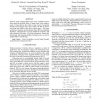Free Online Productivity Tools
i2Speak
i2Symbol
i2OCR
iTex2Img
iWeb2Print
iWeb2Shot
i2Type
iPdf2Split
iPdf2Merge
i2Bopomofo
i2Arabic
i2Style
i2Image
i2PDF
iLatex2Rtf
Sci2ools
ICASSP
2011
IEEE
2011
IEEE
Practical limits in RSS-based positioning
Received signal strength (RSS) based source localization papers often ignore the practical effects of range limits in the measurements. In many devices, this results in some sensors not reporting beyond some maximum range; and in others, the RSS is still observed but may exhibit a noise floor at large ranges. This paper models these situations and demonstrates their effect on positioning algorithms. Measured data is used to validate the cooperative and non-cooperative RSS limits. The Fisher information, Cramer-Rao lower bound, and maximum likelihood estimation error are used to quantify effects on positioning.
ICASSP 2011 | Maximum Likelihood Estimation | Non-cooperative Rss Limits | Signal Processing | Source Localization Papers |
| Added | 21 Aug 2011 |
| Updated | 21 Aug 2011 |
| Type | Journal |
| Year | 2011 |
| Where | ICASSP |
| Authors | Richard K. Martin, Amanda Sue King, Ryan W. Thomas, Jason Pennington |
Comments (0)

